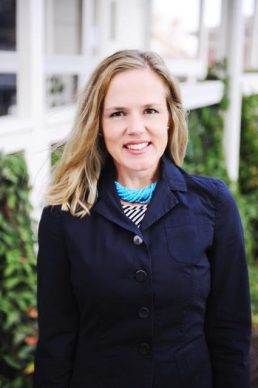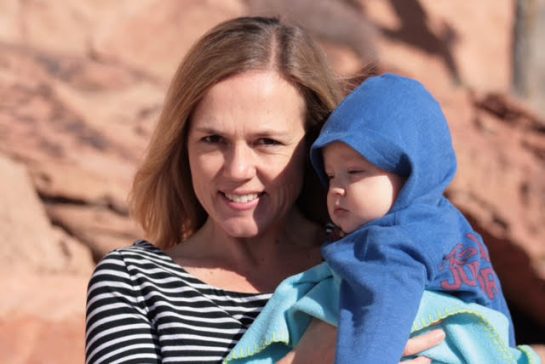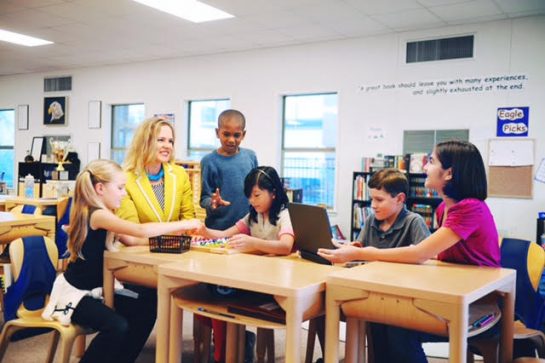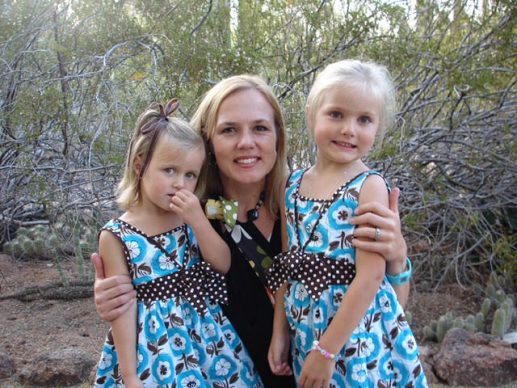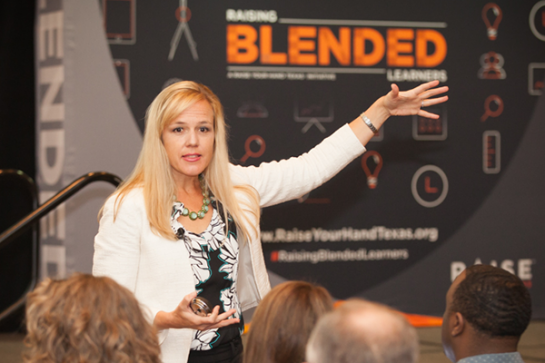Heather Staker is the founder and president of Ready to Blend. She speaks and trains about blended learning, which is any formal education program that combines brick-and-mortar schooling with online learning. She also co-founded and helps produce “Brain Chase,” an online-learning program for 2nd-8th grade students that involves a worldwide hunt for buried treasures. In this interview she talks about the experiences that helped shape her professional interest in improving schools, how she’s felt “quickened” in her efforts to balance motherhood and career pursuits, and her views on the need for a nuanced approach to screen time for kids.
What sparked your interest in educational issues?
I grew up in Orange County, California, the second of seven children. My parents were proactive, hands- on parents who worked hard to build our family. During 11th grade, my English teacher posted applications for all sorts of scholarships and I filled out nearly every one, including an application to be the student member of the California State Board of Education. Each year, California appoints one high school senior to serve on its 11-person board. The student member spends a week each month in Sacramento, as well other time traveling around the state to visit schools and programs. I filled out the application and one thing led to another. Soon the State Board of Education met with me, followed by Governor Pete Wilson’s appointment secretary. Then I appeared before the California senate, which approved my nomination. So as a 17-year-old I gained unusual exposure to state government and the public school system.
The experience was transformative. Seeing point blank the diverse needs of millions of children gave me more empathy, even anxiety, for their varied challenges and hardships. And I left wanting to do more. A one-year term is short, particularly given the demanding learning curve. I resolved then to return to education someday and make a more significant contribution.
Where did you go from there?
The State Board of Education opportunity helped me get into Harvard, where I concentrated in Government and continued to study public policy. After college I took a sales job with Proctor and Gamble. Six months in, a recruiter for Harvard Business School (HBS) contacted me. He said there weren’t enough women at HBS at the time and that the school wanted to recruit younger women who evidenced leadership ability to see if that strategy would reduce the gender gap. So I applied, and at 22 became the youngest person at HBS that year. Two years later, I moved to Los Angeles, where I took a job as a strategy consultant for McKinsey & Company. I was still single all this time.
How did the training you received in your MBA and at McKinsey (a top management consulting firm) prepare you for subsequent career opportunities?
HBS does two things very well. It promotes the ability to go through case-study data, make decisions based on the data, and then defend the position. It’s also a really social place, so that personal and professional network has proven invaluable to me over the long term.
Of any professional experience I have had, McKinsey was the most instrumental in helping me learn to think clearly, organize information, and communicate it in compelling ways to an audience. Working for McKinsey was grueling for the most part, but also indispensable for helping to prepare me mentally for several jobs down the road. Meanwhile, I met Allan Staker, to whom I was immediately attracted, but we were in such different places personally. I was working long hours and traveling each week. I decided that this relationship was really important to me and that I needed to find a way to give it a fair shot. I left McKinsey to work for one of my clients so that my hours would be more reasonable and I could date Allan. We got married eight months later! Then doctors told me that it was unlikely I would ever have children. But I was fortunate to give birth to our first son a year after our marriage.
You now have five children, 12 years old and under. How did your career fit in while having kids?
I have tried everything in terms of career/mother balance. I have not worked at all, worked a little during naptimes, and at times been the sole provider for our family. Allan is the most creative, entrepreneurial soul I have ever met. The day we got back from our honeymoon he quit his job and decided he wanted to invent an Xbox game. So I provided for us for a year while he conceptualized and figured out how to commercialize this invention. When our son was born, I left the company I was working for, and we took turns caring for Tate so that Allan could continue to build up the product development, marketing, and creative aspects of the business. I managed the finances and business planning. Building that company together was an interesting start to our marriage because we discovered each other’s professional strengths and weaknesses—an unusual dimension to add to a relationship! Through so many investor presentations and other meetings together, we learned to cover for each other. We took our son with us everywhere. Often we found a friend in the city that we could leave him with while we went to a quick meeting together, or we just brought him along. It was very much a joint venture between Allan, me, and baby Tate to launch that company.
How did you get from there back into the education sector?
We sold all of the assets from that company to a toy company in New York City and my husband decided that he wanted to go to business school as well. So we went back to HBS for what were my seventh and eighth years in Cambridge. But this time I was the spouse, driving a minivan and living in student housing with three children and a fourth on the way. I took a part-time job as a teaching fellow for Professor Roger Porter’s American Presidency course at Harvard College. I loved the chance to be back in Harvard Yard and found great joy in changing gears from caring for toddlers to focus on teaching and study. I learned that the ten hours or so of teaching time each week provided just the balance I needed at the time.
When Allan graduated in 2009, the housing market tanked and employment was a disaster. Eventually he found a job with Hawaiian Airlines and we moved to Honolulu when Henry, our fourth child, was four weeks old. We soon discovered that Hawaii is an extremely expensive place to live, particularly with our mountain of student debt. Needing to help support our family, I reached out to Clayton Christensen, a professor whom I greatly admire at HBS whose work focuses on how to help organizations innovate. His think tank, the Christensen Institute, offered me a research position within its education practice, and that is where I began writing about blended learning. I found peace in returning to the tough problems that had perplexed me as a student on the State Board of Education and seeing them now through the lens of innovation. It turns out that America has time and again innovated itself out of dead ends and broken models. The same can be true for our schools.
On the personal side, working for the Christensen Institute proved ideal for my circumstances. I have found that the single most important factor to allow me to be in effect a full-time professional and a full-time mother is extreme flexibility. I need to be able to work at night, early dawn, standing on my head, and dancing in circles, if necessary, without the client batting an eye, so long as I deliver above and beyond on my assignments. So that was my agreement with the Institute, and they really held to it, much to their credit.
With the publication of Blended: Using Disruptive Innovation to Improve Schools, which I co-authored with Michael Horn, I stepped aside from my day-to-day work with the Institute. That gave me time to set up Ready to Blend, a consulting group that provides training to schools on blended learning, and to assist with the production of Brain Chase learning challenges.
How do you organize your support system and time to manage your family and career responsibilities?
A few things have been important to me in navigating these years with five young children. One is that I learned that getting paid by the hour is crucial because it monetizes my time. Rather than taking a salary, I try to get paid by the minute so that every moment counts. I’ve also always worked remotely so that there is no face-time requirement and I can work whenever opportunities arise throughout the week. I’ve also accepted that there is a real trade off when you’re trying to do both, in terms of giving enough time both to kids and to work. For me, the sacrifice comes in my social life and discretionary time. But for the past several years, that’s a tradeoff that I have been willing to accept because I’ve felt committed to being present with my children. So I admit I’ve put my social life and free time on the altar. In that sense, I don’t think it’s for everyone. It really is a tradeoff and you can’t have everything—there’s not an easy answer, unfortunately!
Usually I have a part-time nanny or preschool that provides childcare for 12 hours a week and then I do overflow work in the evenings and weekends. I wrote almost every word of Blended in the middle of the night. Several times a month I take a 24-hour trip to do a presentation or deliver a workshop. I can almost always do it within 24 hours. I take the last flight out, deliver the training or presentation in the morning, and fly back immediately. We have a really elaborate system in place of the babysitter combined with my husband for making that work.
My theory is that there are four jobs that moms do. One is to provide physical care—supervision, healthy meals, clean clothes—the custodial stuff. The second is to help them thrive in school and extracurricular activities by being prepared and organized. The third is to love them unconditionally. The fourth is to teach them moral principles and help them find their spiritual footing. With careful organization, I can get those first two jobs done pretty well even when I travel. The third and fourth are hard to delegate, which is why it’s super troubling to all of us if I travel too much.
Every woman’s life is different. I believe that it’s possible to get spiritual direction in life through prayer and that there is a God who provides personal guidance relative to the individual course that is best for each one of us. Because of that we have to assume that each person is heeding the inspiration that is right for her life and circumstances and that no two women are going to follow the exact same pattern. I am grateful that in seeking to align my life to a divine will, my path has emerged as more demanding and interesting than I imagined originally. I have simple faith that I am the spiritual daughter of God and that, when I attune myself to the quiet, spiritual, lovely impressions that are available to all mortal travelers, I can find personalized direction, confidence, and peace.
How do you find time to nurture yourself?
To be honest, it’s a tightrope. I am still trying to figure out two things: social life and self-care. Those are the two places that I come up short the most often. I love exercise. It’s a huge stress relief. I try to get up in the morning before the kids and exercise, but inevitably the kids wake up throughout the night or I stayed up late working on a project and it just doesn’t happen. I used to be in peak shape and now I am fine, but not performance ready. I used to run marathons and now it’s a four-mile loop. My body sends signals, and when my emotions start to turn dark, I pull back and take a nap and regroup. I actually feel that one of the benefits that I can provide doing this interview is being honest and saying for women who want to have it all, there are sacrifices inevitably, and for men too. We are lucky to live when there are a lot of options, but time is the great scarcity of the developed world.
Are there any specific instances where you felt particularly guided to take or not take a specific path?
When I was 21 I thought about serving an LDS mission. At the time women had to be 21, so that was my junior year of college at Harvard. I followed the practice of praying to get an answer about whether or not that was my calling. I felt strongly that I was not to go—and I was surprised! Looking back and seeing the opportunities I had to go straight on to business school and to get married and start a family right away, it makes more sense. One of the principles of my religion that I feel the most committed to is the idea that heaven is willing to fortify and strengthen us and help us in the details of our lives. I love the verse in the book of Isaiah where the Savior says to fear not, I am with you, I will strengthen you, I will help you. As I think back on the countless nights I spent working because I felt that my children were my top daytime priority, I remember feeling so strengthened. I believe that we all have a Savior who can quicken us as we are trying to live as best we can and make the choices that are most aligned to our beliefs.
What do you hope your children learn from your experiences and by seeing your example?
That God delights in human happiness. To discover their own capacity for love and joy-filled relationships. That they have a mother who showed them life is abundant and was compassionate and committed, even when she was tired. To have enthusiasm for the variety of options in the abundant and beautiful lives they are given.
Tell us about your work with blended learning.
Most schools have had computers and technology for decades. So why isn’t it making a difference? Blended learning is not about cramming more computers into schools. It’s about an intentional shift away from teacher-driven instruction toward online learning to give students control over the pace that they work, the path that they take, and the time that they work. That level of student control and agency has not been possible for schools, until now. That’s why online learning is revolutionary. It opens vast new opportunities for students to drive their own learning, experience a more customized path, and learn important skills that the traditional classroom’s passive approach is unable to deliver.
My favorite assignment is to meet with teams of teachers and administrators and expose them to this new paradigm through a workshop experience that itself is blended. I do some of the instruction, but other parts are online, or small group, or project based. They move on as they master the content. Even for adults, the increased engagement, choice, and movement in a blended model are a big relief compared to the structure of the traditional workshops and meetings that they usually attend.
Are you naturally comfortable speaking in groups or how have you prepared to do that?
I have worked on it a lot! I was horrible at first, but I’ve become better. I really love the moments when I can tell an idea clicks and I’ve made a difference for someone.
How do you implement your research on blended learning into your children’s education?
When we were living in Hawaii and I first began writing about blended learning, I interviewed Jeff Sandefer, the co-founder of a school network based in Austin, Texas, called Acton Academy. I was so enamored by its mix of self-paced online learning with rich hands-on projects and face-to-face discussion that I told my husband we simply had to move 3,700 miles so our kids could attend that school! Sure enough, we did. We didn’t know that by moving to Acton Academy we were making a long-term decision about our children’s education. We have found, however, that once our children experienced the ownership and freedom that come with student-driven learning, it would be hard to put them back into a more traditional Industrial-era classroom. Liberty can be ennobling. Acton Academy is masterful at equipping children with the principles and powers they need to manage their own learning, and then setting them free. We’re lifers at this point.
Do you do anything special educationally at home?
When our children have free time and want to get ahead academically, they can log in to their Chromebooks and make progress at home. When they get back to school, all the progress has accrued to their account that’s stored in the cloud. Also the oldest four all participate in Brain Chase each summer, which is fun to do as a family and has advanced them well above grade level in reading, math, and writing. Of course all the research shows that family dinnertime and lots of reading to kids are hugely important practices, so we’re committed to those too.
The way I think about screen time is that there are online super foods—the online destinations that are deeply informative and beautifully designed in step with the best learning science. We use many of these for Brain Chase—Rosetta Stone, Khan Academy, Dreambox, edX, virtual museum tours—those sorts of sites. Then there are the online empty calories—the Netflix Kids channel comes to mind. And then there is just pure poison. So when parents think they have to limit screen time, that’s too broad. Parents need to be more nuanced in their thinking and separate the food from the filth. It’s an amazing era to be a part of, as we have these resources. I’m not scared of them. In fact, I think they are catalyzing the greatest revolution in learning and expansion of knowledge the world has known. I love being a part of it.

At A Glance
Heather Staker
Location: Austin, TX
Age: 39
Marital status: Married
Children: 5
Occupation: Speaker, Trainer, and Author
Schools Attended: Harvard College / Harvard Business School
Languages Spoken at Home: English
Favorite Hymn: For All the Saints
On The Web: readytoblend.com & brainchase.com
Interview by Nollie Haws. Photos used with permission.
At A Glance

